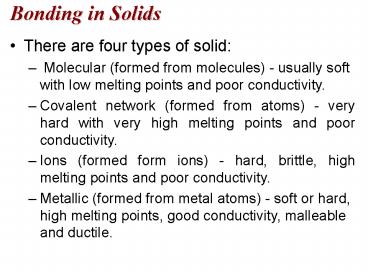Bonding in Solids - PowerPoint PPT Presentation
1 / 26
Title:
Bonding in Solids
Description:
Cation to anion ratio is 1:1. Examples: LiF, KCl, AgCl and CaO. CsCl Structure ... Cation to anion ratio is 1:1. Bonding in Solids. Ionic Solids. Bonding in ... – PowerPoint PPT presentation
Number of Views:2486
Avg rating:5.0/5.0
Title: Bonding in Solids
1
Bonding in Solids
- There are four types of solid
- Molecular (formed from molecules) - usually soft
with low melting points and poor conductivity. - Covalent network (formed from atoms) - very hard
with very high melting points and poor
conductivity. - Ions (formed form ions) - hard, brittle, high
melting points and poor conductivity. - Metallic (formed from metal atoms) - soft or
hard, high melting points, good conductivity,
malleable and ductile.
2
Figure 10.12Examples of Three Types of
Crystalline Solids
3
Bonding in Solids
4
Bonding in Solids
- Molecular Solids
- Intermolecular forces dipole-dipole, London
dispersion and H-bonds. - Weak intermolecular forces give rise to low
melting points. - Room temperature gases and liquids usually form
molecular solids and low temperature. - Efficient packing of molecules is important
(since they are not regular spheres).
5
Bonding in Solids
- Covalent Network Solids
- Intermolecular forces dipole-dipole, London
dispersion and H-bonds. - Atoms held together in large networks.
- Examples diamond, graphite, quartz (SiO2),
silicon carbide (SiC), and boron nitride (BN). - In diamond
- each C atom has a coordination number of 4
- each C atom is tetrahedral
- there is a three-dimensional array of atoms.
- Diamond is hard, and has a high melting point
(3550 ?C).
6
Bonding in Solids
- Covalent Network Solids
7
(No Transcript)
8
Diamond
- Hardest Structure Known - Tetrahedral atomic
arrangement
What hybrid state do you think the carbon has?
9
Bonding in Solids
- Covalent Network Solids
- In graphite
- each C atom is arranged in a planar hexagonal
ring - layers of interconnected rings are placed on top
of each other - the distance between C atoms is close to benzene
(1.42 Å vs. 1.395 Å in benzene) - the distance between layers is large (3.41 Å)
- electrons move in delocalized orbitals (good
conductor).
10
(No Transcript)
11
Graphite
- Form planar sheets - actually more
stable than diamond
What hybrid state do you think the carbon has?
12
(No Transcript)
13
Bonding in Solids
- Ionic Solids
- Ions (spherical) held together by electrostatic
forces of attraction - The higher the charge (Q) and smaller the
distance (d) between ions, the stronger the ionic
bond. - There are some simple classifications for ionic
lattice types
14
Bonding in Solids
Ionic Solids
15
Bonding in Solids
- Ionic Solids
- NaCl Structure
- Each ion has a coordination number of 6.
- Face-centered cubic lattice.
- Cation to anion ratio is 11.
- Examples LiF, KCl, AgCl and CaO.
- CsCl Structure
- Cs has a coordination number of 8.
- Different from the NaCl structure (Cs is larger
than Na). - Cation to anion ratio is 11.
16
Bonding in Solids
Ionic Solids
17
Bonding in Solids
- Ionic Solids
- Zinc Blende Structure
- Typical example ZnS.
- S2- ions adopt a fcc arrangement.
- Zn2 ions have a coordination number of 4.
- The S2- ions are placed in a tetrahedron around
the Zn2 ions. - Example CuCl.
- Fluorite Structure
- Typical example CaF2.
- Ca2 ions in a fcc arrangement.
- There are twice as many F- per Ca2 ions in each
unit cell. - Examples BaCl2, PbF2.
18
Bonding in Solids
Ionic Solids
19
Bonding in Solids
- Metallic Solids
- Metallic solids have metal atoms in hcp, fcc or
bcc arrangements. - Coordination number for each atom is either 8 or
12. - Problem the bonding is too strong for London
dispersion and there are not enough electrons for
covalent bonds. - Resolution the metal nuclei float in a sea of
electrons. - Metals conduct because the electrons are
delocalized and are mobile.
20
Bonding in Solids
Metallic Solids
21
The Molecular Orbital Energy Levels Produced
When Various Numbers of Atomic Orbitals Interact
22
The Band Model for Magnesium
23
Partial Representation of the Molecular Orbital
Energies in A) Diamond and B) a Typical Metal
24
Figure 16.33 Empty/filled MOs
25
Silicon Crystal Doped with (a) Arsenic and (b)
Boron
26
Figure 16.34 p-n junction

